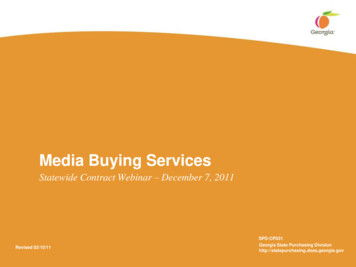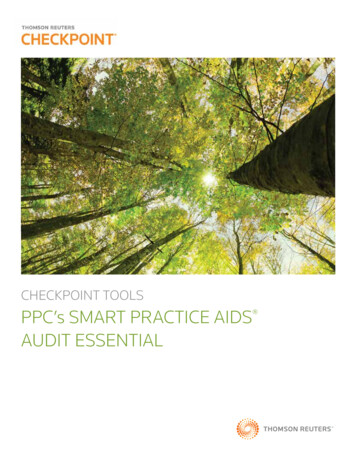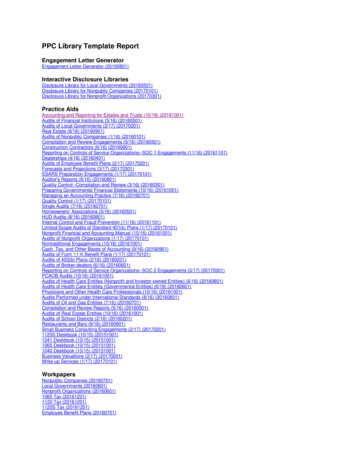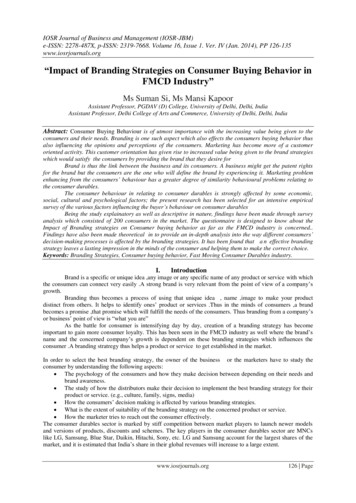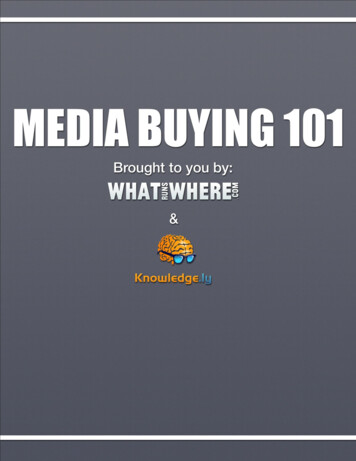
Transcription
Media Buying 101We’ve put together a small guide on display media buying. This guide will cover the pre media buyresearch you need to do to get ready to start your media buy as well as limit your risk and improve yourreturn on investment while buying, the types of display media buys you can do and what to rememberwhen you’re actually negotiating the terms of your media buy. Let’s get started .
The Pre-BuyBefore you start buying media you need to do some research. There are a couple parts of this,demographic research and competitive analysisDemographic ResearchYou can do demographic research for free using many websites found around the web. You can alsopay for this information from providers like ComScore. The information on these may not be 100%accurate, but will give a pretty good picture about what’s happening around the web. The free siteswe’re going to dig into are alexa.com, quantcast.com and Google Ad Planner (google.com/adplanner).Alexa.com: What is Alexa? To quote from their website “Alexa is continually crawling all publiclyavailable websites to create a series of snapshots of the web. We use the data we collect to createfeatures and services. Alexa employs web usage information, which tells us what's being seen on theweb by real people. This information comes from our community of Alexa Toolbar users”. By doing asearch for a domain, demographic information becomes available for free.Quantcast.com: Quantcast provides worldwide audience and demographic data. Quantcast couplesmachine learning with massive quantities of directly measured data to deliver detailed audience data inreal-time. Search any website within Quantcast to get measured demographics and volume results.Google Ad Planner: Google Ad Planner takes demographic information as collected by Google andallows you to search for websites demographics to better plan media buying campaigns.Now you know how to find demographics, who should you be targeting? You can use your own websiteto see demographics if you have analytic software installed, or you can base it off your competitor’swebsite demographics. The other way to do demographic analysis is by evaluating competitor’scampaigns, not their site. Who are they specifically targeting? By doing this research you’ll be able tofind websites who has an audience that matches your demographic needs to buy media from, orpresent these metrics to ad networks to better target your media buy.
Important demographic metrics: gender, age, children, income, education, ethnicityAge – For the most part age and/or gender is going to be your most important demographic category totarget.Gender – in some cases, gender won’t matter, in others it will. For examples, the cosmetics niche willprobably do better with a female audience versus a male audience.Education– This will depend on your target audience. For example, if you are doing lead generation foran MBA or graduate program, you obviously would want to target sites that cater to individuals with ahigher education level.Has Children – Again, depending on your target audience this could be a key demographic. Forexample, if a source is predominately male and doesn’t have a child that is probably not a good placeto promote any sort of baby or parenting guides.Income: Income levels matter for the type of product you are trying to promote. If it is a high costproduct, let’s say a private jet, targeting low income demographics may not yield the best results.Ethnicity:If you have ethnic specific markets or products, this metric becomes pretty important.Competitive IntelligenceUsing competitive intelligence platforms will save you a lot of time and provide a much more detailedunderstanding of what is working in competitors ads and media buy campaigns. This information isvaluable because by using the information on what is actually working for them, you can find whatthey’ve spent money and time testing and what to not waste money using. WhatRunsWhere.com is acompetitive intelligence platform for media buying that is a must have for any media buyer, brand newor an old veteran.Once logged in, you can search by advertiser, website or ad network to find out what is performing bestfor any of the three search options. This allows you to quickly see top ads, placements and trends. Bytaking what a competitor has already spent money testing and perfected and improving on it, you’reable to save a lot of time and money once you launch your media buy.When using the tool you want to try to get Key Performance Indicators (KPI). These include, targetdemographics (of the places they’re advertising on and who’s coming to their website) and ad copy. Byspotting recurring trends and themes in this information you can turbo charge your media buy and get ahuge leg up from the get go (or use it to bring an existing campaign to a whole new level of profitabilityand scale).
Where to Put Your Media BuyThere are two basic types of media buys:Direct buy: buying ad space directly on a website from the website owner. For example doing a mediabuy on nba.com would be an example of a direct media buy.Network/Agency buy: buying ad space through a third party network or agency, examples include:Google Adwords Content Network, MSN Content Network, AOL Adsonar, Pulse360, Interclick, TribalFusion, Blue Lithium, BuySellAds, Burst Media, Rubicon Project, 247 Real Media, Contextweb,Valueclick, Adbrite and there are hundreds more.In the following section we are going to go through the basics of each type of buy and what it exactlythey are/it entails.
Network/Agency Buy MethodologyAd networks are companies that aggregate available ad space across a large number of websites(publishers) and sell it to an advertiser. There are many types of ad networks from the very large toniche ones targeted to a specific audience. By going to these networks and buying from them, you canachieve a large reach for your ads and scale your campaigns quickly by leveraging their depth andbreadth of publishers available.Pros of ad networks: Set up quickly, Test a lot of sites fast, Potential to Scale, Swap out ads andcontent quickly, work with a representative to optimize your media buyCons of ad networks: Traditionally there is more risk (higher minimums to start buying), Varyinglevels of actual transparency, reliance on a representative to do their job, you don’t necessarily knowwhere your ads are showing up (there is a degree of black box effect)Examples of some ad networks include CPX Interactive, Blue Lithium, ValueClick, AdBrite, and manyothers.Media Buying via Demand Side Platforms (DSP)Media buying is constantly changing and evolving. New technology and ways to buy and sell ads arealways being developed. One trend that has caught on in the last little bit is a new platform that takesdemand side platforms (DSP) audiences (a DSP is a platform that allows advertisers to buy traffic) andallows you to buy it form a single interface. This technology is known as Real Time Bidding or RTB.“Real-time bidding (RTB) is a relatively new advertising technology that allows online advertising to bepurchased and served on the fly. Instead of reserving prepaid advertising space, advertisers bid oneach ad impression as it is served. The impression goes to the highest bidder and their ad is served onthe page. The closest analogy would be to the stock market: as stocks (online advertising spaces)come up for sale, brokers (advertisers) bid for the stock. Whoever bids the highest price gets that stock(the ad is served). Then the process immediately starts all over again.” (Taken from thecrowdscience.com blog)RTB platforms allow you to bid on a huge amount of inventory from a lot of different sources in oneinterface. Each RTB platform is different and the capabilities are different too. Some allow you to justbid on traffic networks or audiences like AdBuyer.com, while others like SiteScout.com allow you to bidon specific websites allowing you to essentially do single site placements on a mass scale. This allowsa quicker and easier way to set up and manage campaigns as well as making the media process lesslabor intensive than it has been in the past.
The other nice thing about most RTB platforms is that they require a very low minimum (usuallybetween 500-1000) to start buying through. Examples of DSP platforms include MediaMath, Turn andSiteScout.com.Direct Buy MethodologyDirect buys are going on a website by website basis and buying inventory directly from the websiteowner or company.Pros of Direct Buys: Tap into high volumes of traffic, cut out middle men (such as ad networks), buildrelationships with direct websites for future buys, lock inventory in creating barriers to entry forcompetitionCons of Direct Buys: Time consuming to locate direct buy sources (unless you use spy tools likeWhatRunsWhere where the information is condensed for you), Need to monitor a lot of websites, needto pay for a third party ad server to deliver for ads onto the site (Examples of adservers includeSiteScout.com, AdShuffle.com, Zedo.com), scaling is a harder and more manual process, timeconsuming to manage and optimize a lot of direct buys on an individual basisBy buying directly you have more transparency on what is actually happening with your advertising andmore control of the traffic sources where your ads are placed.To find direct sites to buy from you can use tools like WhatRunsWhere.com, Google Ad Planner, andQuantcast.com. These tools have research and planning capacities that will generate lists of websitesthat fit with your media buy plan (Quantcast.com and Google Ad Planner) or that your competitors areusing to already buy media from (WhatRunsWhere.com).Contact these websites directly after you’ve found them is the first step to having a direct buy up andlive in no time!
Negotiating the Media BuyNow that you’ve found where you want to actually run your media buy, it’s time to negotiate what you’regoing to pay for it. We’re going to try to give a high level overview of pricing structures in the mediabuying world. There are three basic pricing structures:Cost per Thousand Impressions (CPM): A CPM is how much you will pay per thousand impressionsof your ad during your buy. For example if you have a 1 CPM, you will pay 1 every time your ad isshown 1000 times.Cost Per Click (CPC): A CPC is how much you will pay ever time your ad is clicked. For example, ifyou have a 0.50 CPC, you will pay 50 cents each time that someone clicks your ad.Cost per Action (CPA): A CPA is how much you will pay when a designated action is performed. Forexample, if you negotiate that a signup is worth 5, then whenever someone completes that action(sign up), you will pay 5.There are generally two types of inventory available on media buys, premium and remnant inventory.Premium inventory is normal high quality inventory. Remnant inventory is unsold or lower qualityinventory. As you can imagine premium inventory is usually more expensive on a site by site basiswhile remnant inventory is cheaper. The type of inventory you want to buy depends on your goals andbudget for the campaign.The Insertion OrderUnless you are buying directly through a self-serve RTB platform (For example SiteScout.com), you willcome across an insertion order. An insertion order is a formal, printed order to run an ad campaign.Typically an insertion order identifies: Typically, the insertion order identifies the campaign name, thewebsite or ad network receiving the order and the planner or buyer giving the order, the individual adsto be run (or who will provide them), the ad sizes, the campaign beginning and end dates, the feestructure, the estimated total cost per billing period, discounts to be applied, reporting requirements andpossible penalties or stipulations relative to the failure to deliver the impressions, out clause (themaximum time needed to stop the buy in case of failure or issue). Insertion orders vary per order sothere is no one size fits all templates.
ConclusionHopefully this guide has given a better understanding on how to research and pick the type of mediabuy to do as well as what you need to understand when you are ready to actually execute the mediabuy. Happy buying!About WhatRunsWhere.com: WhatRunsWhere is a competitive intelligence service for online mediabuying. It allows you to look up what advertisers are doing online, where they are running ads, fromwho they are buying inventory, and what exact ads they are using. WhatRunsWhere allows you to seewhat is happening on any website: who is advertising there, who is selling the inventory for them, andwhat ads they are running. With data from multiple countries and actionable insights from the data,WhatRunsWhere quickly allows anyone to dissect advertising campaigns, resulting in reduced risk anda higher ROI for online advertising campaigns. Try it today for just 1 at www.whatrunswhere.com
to pay for a third party ad server to deliver for ads onto the site (Examples of adservers include SiteScout.com, AdShuffle.com, Zedo.com), scaling is a harder and more manual process, time consuming to manage
